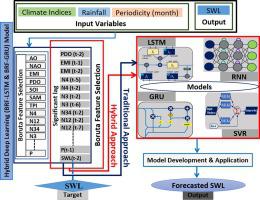Journal of Hydrology ( IF 5.9 ) Pub Date : 2021-05-01 , DOI: 10.1016/j.jhydrol.2021.126350 A.A. Masrur Ahmed , Ravinesh C. Deo , Qi Feng , Afshin Ghahramani , Nawin Raj , Zhenliang Yin , Linshan Yang

|
Long-term forecasting of any hydrologic phenomena is essential for strategic environmental planning, hydrologic and other forms of structural design, agriculture, and water resources management. Climate mode indices, utilising machine learning methods, are frequently considered as predictor variables in order to forecast several different hydrological variables. In this study, a feature selection algorithm based on two different deep learning models, i.e., long short-term memory and a gated recurrent unit, is applied to improve the forecasting capability of streamflow water levels at six gauging stations in the Murray Darling Basin of Australia. This paper therefore aggregates the significant antecedent lag memory of climate mode indices, rainfall, and the monthly factor based on the periodicity as the predictor variables to attain significantly accurate stream water level forecasts. This novel method identifies an improved relationship between the stream water level and climate mode indices through the aggregation of the significant lagged datasets capturing the historical features to predict the future streamflow water level. The boruta feature selection algorithm (BRF) was then applied in a two phase process before and after attaining the significant lagged inputs to screen the optimum predictor variables. The merits of the forecast models were evaluated through different performance evaluation criteria. The results show that the accumulated significant lagged inputs based on climate mode indices, along with the rainfall and periodicity factors are seen to provide improved forecasting of the SWL over the non-BRF deep learning approaches where no prior feature selection was applied. The hybrid LSTM method (i.e., BRF-LSTM model) achieved a unique advantage in terms of SWL forecasting, particularly attaining over 98% of the predictive errors lying within a band of +/-0.015 m with relatively low relative errors (RRMSE ≈1.30% and RMAE ≈ 0.882%), outperforming all of the benchmark models. It is also found that the periodicity factor has a potential influence on the accuracy of the forecast models for the four monitored study stations. This study concludes that the newly developed hybrid deep learning approaches, coupled with the BRF feature selection, provide improved forecasting performance. The hybrid approach developed in this paper can therefore be used to provide a strong provide predictive response algorithm for the hydrological variables that were influenced by the low-frequency variability of the climate model indices in respect to streamflow water level.
中文翻译:

带有Boruta-Random森林优化器算法的深度学习混合模型,用于基于气候模式指数,降雨量和周期性的流量预测
任何水文现象的长期预报对于战略环境规划,水文和其他形式的结构设计,农业以及水资源管理都是必不可少的。为了预测几种不同的水文变量,利用机器学习方法的气候模式指数通常被视为预测变量。在这项研究中,基于两个不同的深度学习模型(即长短期记忆和门控循环单元)的特征选择算法被应用于提高六种测量中的水流水位预测能力 澳大利亚墨累达令盆地的加油站。因此,本文基于周期性作为预测变量汇总了气候模式指数,降雨量和月度因子的显着前期滞后记忆,以实现明显准确的溪流水位预测。通过收集捕获历史特征以预测未来水流水位的重要滞后数据集,该新颖方法可以识别出水流水位与气候模式指数之间的改进关系。然后,在获得明显的滞后输入之前和之后,将Boruta特征选择算法(BRF)应用于两个阶段,以筛选最佳预测变量。通过不同的绩效评估标准对预测模型的优劣进行了评估。结果表明,与未应用先前特征选择的非BRF深度学习方法相比,基于气候模式指数的累积显着滞后输入以及降雨和周期性因子可以改善SWL的预测。混合LSTM方法(IE。,BRF-LSTM模型)在SWL预测方面取得了独特的优势,特别是在+/- 0.015 m的范围内以相对较低的相对误差(RRMSE≈1.30%和RMAE≈0.882)获得了98%以上的预测误差%),胜过所有基准模型。还发现周期性因素对四个受监测研究站的预测模型的准确性有潜在影响。这项研究得出的结论是,新开发的混合深度学习方法与BRF特征选择相结合,可以提供更好的预测性能。











































 京公网安备 11010802027423号
京公网安备 11010802027423号